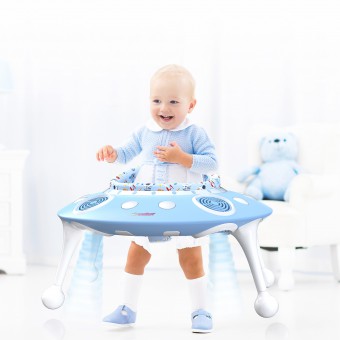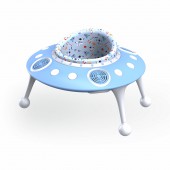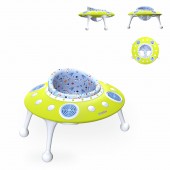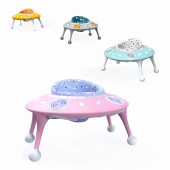DESIGN NAME:
AirWalker
PRIMARY FUNCTION:
Infants Walker
INSPIRATION:
Research from American Academy of Pediatrics indicates that conventional walkers actually delay independent walking because they do not help the child in learning postural control, balance and weight shifting. They do not help in muscle development and do not support baby natural reflexive response .
UNIQUE PROPERTIES / PROJECT DESCRIPTION:
AirWalker addresses the challenges posed by conventional walkers. As the name suggests, AirWalker is an air-assisted walking device based on quadcopter technology (also referred as UAV technology), which is commonly used in drones. It consists of four propellers that provide a gentle lift to the child of about half of her body weight, which encourages the child to stand and balance the body using her own muscles. It provides a gentle lift but does not advances by itself, which encourages the child to use her muscles to move forward. It helps the child in learning balance, postural control, weight shifting, and in developing muscle strength in a more natural way. This way AirWalker makes the process of learning to walk more natural and fun.
OPERATION / FLOW / INTERACTION:
AirWalker rests on its four legs when in rest position. Parents can switch ON the device once the infant sits on AirWalker. Propellers start to rotate, providing a gentle 3-4Kg lifting force, which is approximately half the average weight of an 8 month old child. This lift encourages the child to use her leg muscles to stand. Once she tries to stands, the AirWalker lifts from the ground with its four legs approximately 4-6 inches above the ground. Child can now learn to balance and gain postural control. She can use her muscles to move forward or sideways. During this process, whenever the child sits on the seat, her weight brings the AirWalker down and it would rest on its four legs. In-built sensors keeps the AirWalker always in horizontal position, and limited motor capacity prevents it from lifting more than 6 inches above the ground.
PROJECT DURATION AND LOCATION:
The concept design of the AirWalker started in Jan 2021 and was finalized in Feb 2021.
|
PRODUCTION / REALIZATION TECHNOLOGY:
AirWalker is an air assisted walking device based on quadcopter technology (also referred as UAV technology), which is commonly used in drones. It consists of four propellers that provides a gentle lift to the child from the ground. Quadcopter technology used in AirWalker is being used in various products such as remote-assisted drone toys and camera integrated drones.
SPECIFICATIONS / TECHNICAL PROPERTIES:
Dimensions of AirWalker: width 600mm x height 400mm x depth 600 mm. Suitable for babies 6-14 months old.
AirWalker has several safety features thoughtfully integrated in the design that makes it very safe to use.
An in-built height sensor ensures that the device does not lift more than 6 inch above the ground (distance of the leg from the ground).
Even when the child user is not sitting on AirWalker, it would not hover more than 6 inch above the ground.
The height and level sensors keep the AirWalker in horizontal position even when it hovers on an uneven surfaces such as stairs. This makes it very safe for the child.
Maximum lifting force of the propellers is limited to 4kg only, which is approximately half of the average weight of an 8 month old child. Although, the device also has a height safety sensor, having limited lifting capacity provides double protection by ensuring that it does not lift the child beyond the desired height.
An in-built weight sensor ensures that the lifting capacity is further reduced in case a child with lesser weight uses the device.
The propellers only provide a vertical lift to the AirWalker, which means that it can only hover but cannot move forward by itself. This encourages the child to use her muscles to advance forward.
In-built rechargeable lithium ion battery provides wireless power to the product. This ensures that the devise is wireless when in use.
Safety grills above the propellers ensure that child cannot insert her fingers in the propeller.
TAGS:
Baby Walker, Drone Walker, Kids, Learning to Walk, Baby Walking, Drone
RESEARCH ABSTRACT:
Research from American Academy of Pediatrics show that walkers rather impede or delay independent walking and are unsafe to use. Conventional walkers do not help in learning postural control, balance, weight shifting, muscle development and do not support baby’s natural, reflexive response . Rather than providing a gentle lift to the child, they provide a seating on the rolling wheels, which drifts them away from the natural process of learning to walk.
1.American Academy of Pediatrics Committee On Injury And Poison Prevention. (1995). Injuries Associated With Infant Walkers. Pediatrics, 95(5), 778-780.
2.Siegel, A. C., & Burton, R. V. (1999). Effects of baby walkers on motor and mental development in human infants. Journal of developmental and behavioral pediatrics: JDBP, 20(5), 355-361.
3.Garrett, M., McElroy, A. M., & Staines, A. (2002). Locomotor milestones and babywalkers: cross sectional study. Bmj, 324(7352), 1494.
4.Schecter, R., Das, P., & Milanaik, R. (2019). Are Baby Walker Warnings Coming Too Late?: Recommendations and Rationale for Anticipatory Guidance at Earlier Well-Child Visits. Global pediatric health, 6, 2333794X19876849.
CHALLENGE:
There were two main challenges in the project:
1.Past research indicates that conventional walkers do not help in learning postural control, balance, weight shifting, muscle development and do not support baby’s natural, reflexive response. The most challenging part of the design was conceiving and developing a walker for child that would make the process of learning to walk more natural and playful.
2.Another challenge for us was to ensure that this product is unquestionably safe for the child. We thoughtfully integrated safety features (described in the specification section) to make it an absolutely safe and error-proof design
ADDED DATE:
2021-02-17 12:02:49
TEAM MEMBERS (2) :
Designer: Satyakam Sharma and Designer: Himanshu Shekhar Soni
IMAGE CREDITS:
Satyakam Sharma and Himanshu Soni, 2020.
|









